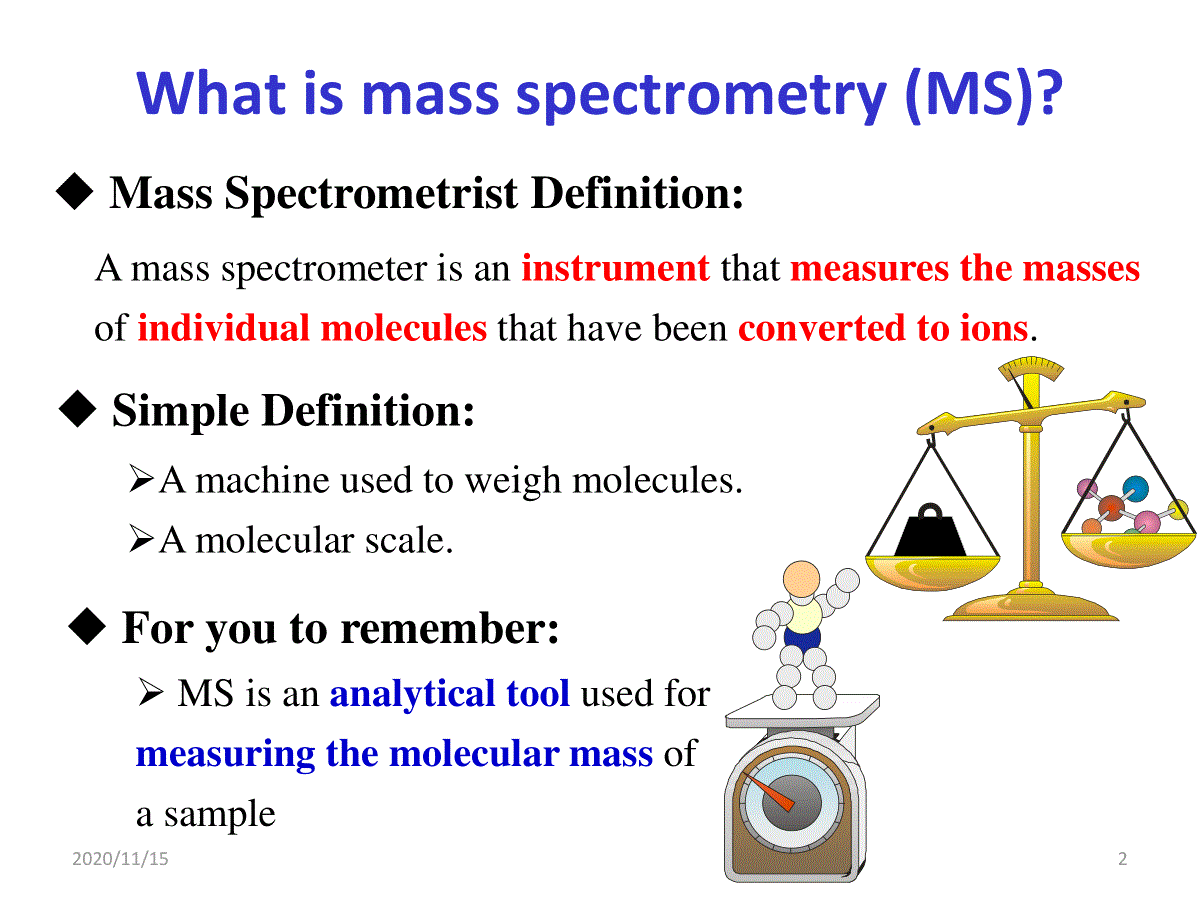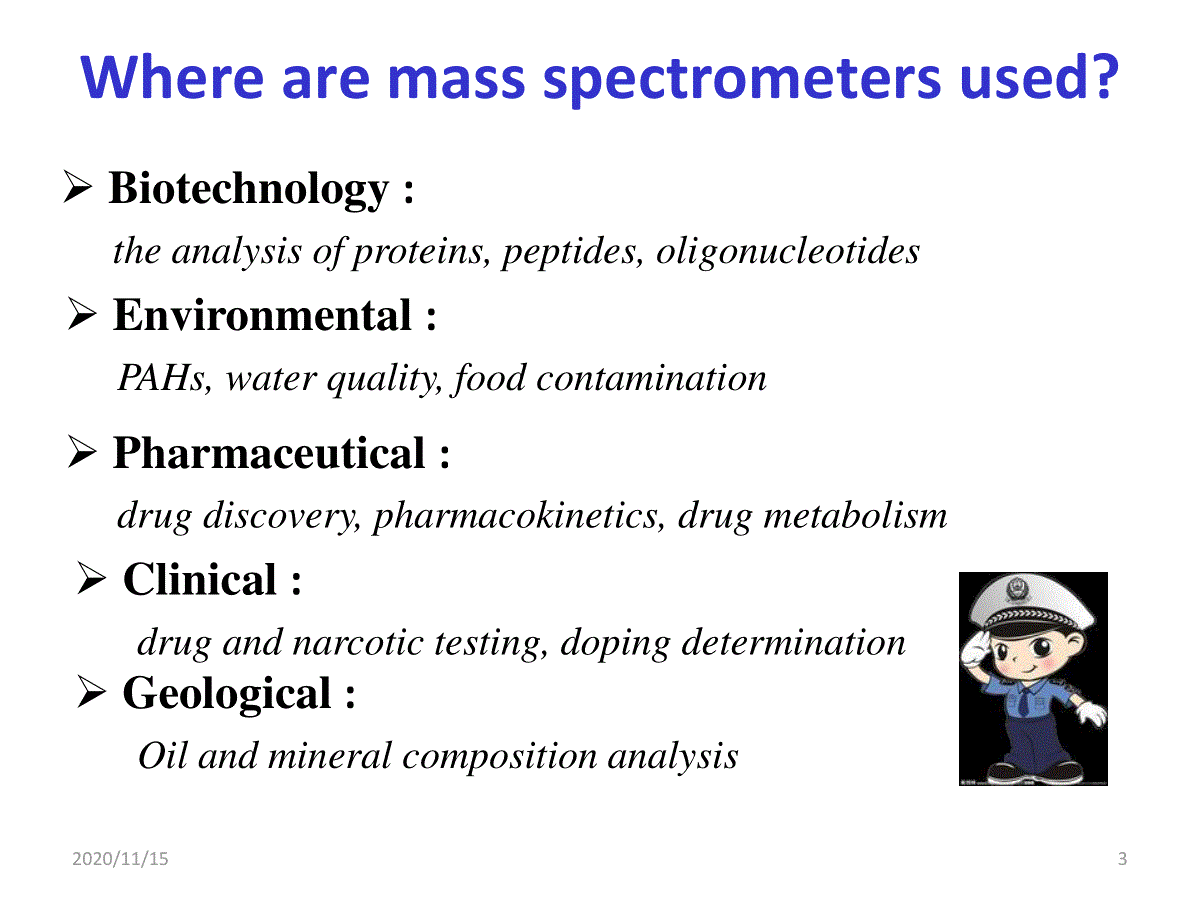当前位置:首页 > 商业/管理/HR > 企业财务 > Mass-Spectrometry
MassSpectrometry(MS)10.00.20.40.60.84x10Intens.[a.u.]200250300350400m/z质谱现代分析技术之质谱2020/11/15Whatismassspectrometry(MS)?2MassSpectrometristDefinition:Amassspectrometerisaninstrumentthatmeasuresthemassesofindividualmoleculesthathavebeenconvertedtoions.Foryoutoremember:MSisananalyticaltoolusedformeasuringthemolecularmassofasampleSimpleDefinition:Amachineusedtoweighmolecules.Amolecularscale.2020/11/15Wherearemassspectrometersused?3Biotechnology:theanalysisofproteins,peptides,oligonucleotidesEnvironmental:PAHs,waterquality,foodcontaminationPharmaceutical:drugdiscovery,pharmacokinetics,drugmetabolismClinical:drugandnarcotictesting,dopingdeterminationGeological:Oilandmineralcompositionanalysis2020/11/15Howisamassspectrometerused?4Massspectrometristdefinition:Massspectrometry(MS)isapowerfultechniquethatisusedtoidentifyunknowncompounds,toquantifyknownmaterials,andtoelucidatethestructureandchemicalpropertiesofmolecules.SimpleDefinitionAmassspectrometerisusedtohelpscientists:1.Identifymoleculespresentinthesamples2.Determinethequantityofeachtypeofmolecule3.Determinewhichatomscompriseamoleculeandhowtheyarearranged2020/11/15WhatareadvantagesofMS?•Highselectivityandspecificity•Highsensitivity(µg-ng,comparedwithmgforNMR)•HighthroughputProvidemolecularweightandstructureinformationEasycouplingwithseparationtechniques,suchasgaschromatography(GC),high-performanceliquidchromatography(HPLC),capillaryelectrophoresis/electrochromatography(CE/CEC).52020/11/15质谱分析法特点应用范围广:同位素质谱、无机质谱和有机质谱,分析对象既可以是无机物,也可以是有机化合物;既可以是气体和液体,也可以是固体。灵敏度高:目前有机质谱仪绝对灵敏度可达50pg(10-12g),无机质谱仪绝对灵敏度可达10-14g分析速度快(可在数秒至数分钟内完成一次测试)并可以实现多组分同时检测,既能够进行定性分析,又能进行定量分析。能同时提供有机样品的精确相对分子质量、元素组成、碳骨架及官能团和结构信息。62020/11/15•质谱仪与计算机的结合使用,不仅简化了质谱仪的操作,而且扩展了质谱仪的分析能力,使MS成为测定有机化合物结构强有力的工具。得到质谱图后,计算机与数据库中的几十万个标准图谱可以自动对照,从而提供可能的样品名称、分子式和结构式。•易于与分离技术联用,GC,HPLC,CE,CEC•样品用量少(µg~ng,而NMR样品需求量为mg)•与其它仪器相比,质谱仪结构复杂,价格昂贵,使用及维修比较困难。•样品被破坏,无法回收72020/11/15仪器及原理当具有一定能量的电子流冲击气态有机分子时,会使分子失去一个价电子成为带一个正电荷的分子离子。8有机分子形成分子离子的离子化电压(离解能)为9~15eV,但一般所用冲击电子流的能量通常为50~80eV,常规为70eV,此时电子流的能量比离解能高很多,受轰击的离子除了形成分子离子外,还会形成大量的碎片离子。带正电荷的分子离子及碎片离子按质荷比大小以此经过质谱仪,在相应的质荷比(m/z)值处出先锋,并依质荷比(m/z)大小排列得到质谱图。2020/11/15Amassspectrumwillusuallybepresentedasaverticalbargraph(垂直条形图),inwhicheachbarrepresentsanionhavingaspecificmass-to-chargeratio(m/z)andthelengthofthebarindicatestherelativeabundanceoftheion.9横坐标表示质荷比(m/z)纵坐标表示表示相对强度relativeintensity或相对丰度(relativeabundance)2020/11/1510Basepeak:thepeakhasthegreatestintensity,whichisassignedanabundanceof100Molecularionpeak:thepeakrepresentingthemolecularioninamassspectrum.Molecularionisbiggerthanitsfragmentsandshouldbeontherightsideofthespectrum.纵轴是以图中最强的离子峰(称为基峰)的峰高作为100%2020/11/15TheDevelopmentHistoryofMS•世界上第一台质谱仪于1912年由英国物理学家JosephJohnThomson(1906年诺贝尔物理学奖获得者,贡献:电荷在气体中的运动、英国剑桥大学教授)研制成功。•TheWorld'sfirstcommercialinstrumentbecameavailablein194811•40年代:用于同位素测定和无机元素分析(FW阿斯顿1922年诺贝尔化学奖质谱技术发现同位素)2020/11/15•50年代:开始有机物分析(分析石油)•60年代:研究GC-MS联用技术•70年代:计算机引入•80年代:新的质谱技术出现:快原子轰击电离子源,基质辅助激光解吸电离源,电喷雾电离源,大气压化学电离源;LC-MS联用仪,感应耦合等离子体质谱仪,富立叶变换质谱仪等•目前质谱分析法已广泛地应用于化学、化工、材料、环境、地质、能源、药物、刑侦、生命科学、运动医学等各个领域。122020/11/15HowdoesaMSwork?13Picturetakenfromwikipedia.org0.00.20.40.60.84x10Intens.[a.u.]200250300350400m/z1.Neutralmoleculesgointotheionsource,wheretheyareionized.2.Ionsareacceleratedandgointotheanalyzer,wheretheyareseparated.3.Separatedionsaredetectedindividuallyinthedetector.Thesignalsarecollectedandintegrated.Massspectrum2020/11/15SoftElectronimpact(EI)Chemicalionization(CI)Fastatombombardment(FAB)Electrosprayionization(ESI)AtmosphericPressureChemicalIonisation(APCI)MatrixAssistedLaserDesorptionIonisation(MALDI)14InletIonizerAnalyzerDetector1.Directprobe2.CoupledwithGC,LC,CE/CEC3.MembraneinfusionMagneticsectorTime-of-flightIontrapQuadrupolefilterVacuumSchematicofamassspectrometerABCD进样系统离子源分析器检测器2020/11/1515A.InletSystems(进样系统)Inletintroducessamplemoleculesintotheionsourceefficientlyandrepetitivelywithouthamperingthevacuum.Sometimes,theinletisintegratedwiththeionsource.directprobesamplesemi-permeablemembraneIonsourcemembraneinfusionGCvaporinductionLiquidchromatographyCapillaryelectrophoresisCapillaryelectrochromatography2020/11/15InletSystems(进样系统)16InletApplicabletoSuitableionizationmethodsLoadingVaporVolatile,easilyvaporizedcompoundEI,CImgDirectprobeLessvolatilecompoundEI,CImgGCMixturesingasphase,volatilecomponentEI,CImgLC,CE/CECMixturesinsolution,lessvolatilecomponentESI,APCImgMembraneMixturesinsolution,volatilecomponentEI,CImM2020/11/1517进样系统进样系统的作用是高效重复地将样品引入到离子源中,并且不能造成真空度的降低。常用的进样装置有三种类型:间歇式进样、直接探针进样、色谱进样系统(GC-MS、HPLC-MS)和高频感藕等离子体进样系统(ICP-MS)等。1)直接探针进样:高沸点液体及固体探针杆通常是一根规格为25cm6mm,末端有一装样品的黄金杯(坩埚),将探针杆通过真空闭锁系统引入样品2020/11/15色谱质谱联用(GC-MS,LC-MS)SampleSample58901.0DEG/MINHEWLETTPACKARDHEWLETTPACKARD5972AMassSelectiveDetectorDCBAABCDGasChromatograph(GC)MassSpectrometer(MS)SeparationIdentificationBACD2020/11/1518IonSource(离子源)19Ionsourceistoinducecharges(positiveornegative)intoneutralmoleculestogenerateions.•质谱仪的分析对象是离子,因此,首先要把样品分子或原子电离成离子。产生离子的装置为离子源,离子源内的压力约为10-5Pa.•在质谱仪中,要求离子源产生





 三七文档所有资源均是用户自行上传分享,仅供网友学习交流,未经上传用户书面授权,请勿作他用。
三七文档所有资源均是用户自行上传分享,仅供网友学习交流,未经上传用户书面授权,请勿作他用。
本文标题:Mass-Spectrometry
链接地址:https://www.777doc.com/doc-7241914 .html